Home » Volcanoes » Yellowstone Volcano
The Volcano Beneath Yellowstone
The "Yellowstone Supervolcano" produced some of Earth's largest eruptions.
Videos featuring Jake Lowenstern, USGS Scientist in Charge of Yellowstone Volcano Observatory - April 16, 2009
USGS Scientist-in-Charge of Yellowstone Volcano Observatory, Jake Lowenstern, explains volcanic features at Yellowstone and answers several interesting questions which include: "How do we know Yellowstone is a volcano?" and "What is a Supervolcano?"
Volcanoes at Yellowstone?
Yellowstone National Park is world-famous for its geysers and hot springs. Those thermal features are easy-to-observe evidence of an active magma system beneath the Park. This magma system has produced some of the largest volcanic eruptions in Earth's history - eruptions so large that they have been called "supervolcanoes." One of these eruptions produced a caldera that is about 50 miles across.
Should you be concerned about this? Here are three facts... 1) the most recent super eruption occurred about 640,000 years ago; 2) scientists monitoring the activity at Yellowstone today say "nothing unusual is happening right now"; and, 3) a gigantic eruption is expected to be preceded by significant warnings.
What is a Supervolcano?
A supervolcano is an eruption that rates a magnitude of 8 on the Volcanic Explosivity Index. The VEI is a scale that rates eruptions on their ejecta volume, plume height and duration. The scale ranges from 0 through 8. Only a few dozen eruptions in all of Earth's history are known to have a VEI of 8. Two of those eruptions, the Lava Creek eruption (640,000 years ago) and the Huckleberry Ridge eruption (2.2 million years ago), occurred at Yellowstone. These eruptions were given the VEI rating because their ejecta volume exceeded 1000 cubic kilometers!
Jake Lowenstern introduces you to the Yellowstone Volcano Observatory and explains the methods of monitoring now being used.
How Active is the Yellowstone Volcano?
The Yellowstone Volcano Observatory closely monitors earthquake activity, ground deformation, streamflow and stream temperatures in the Yellowstone area. Occasional earthquake swarms occur, the ground surface changes elevation and streams change in both discharge amount and temperature. They have no evidence to suggest that a volcanic eruption of any size will happen at Yellowstone in the foreseeable future.
When Was the Last Yellowstone Eruption?
The most recent volcanic eruption at Yellowstone occurred about 70,000 years ago and produced the lava flows of the Pitchstone Plateau. The lava flows of this eruption covered an area about the size of Washington, D.C. and are up to 100 feet thick.
Jake Lowenstern traces some of the volcanic history of the Yellowstone area, explains recent earthquake swarms and comments on future eruptive activity.
What Causes This Volcanic Activity?
There is a hot spot beneath Yellowstone. A hot spot is a persistent plume of hot material rising through Earth's mantle. This rising plume delivers heat to the area, causes forces in the crust that produce earthquakes and rarely produces a volcanic eruption. A hotspot is also responsible for the volcanic eruptions of Hawaii.
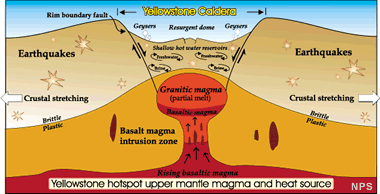
Yellowstone geysers: Hot rock down below is what drives the geysers of Yellowstone National Park. Rain water infiltrates into the ground and enters a groundwater circulation system. Some of this water circulates deeply, is superheated and then blasted out of a geyser. Image by the National Park Service.
What Causes the Geysers?
The magmatic activity below Yellowstone causes rock beneath the Park to be much hotter than subsurface rock in other areas. Water that falls as rain or snow above these rocks can infiltrate into the ground and enter the groundwater system. Some of this water encounters the hot rock below and is heated to well above the boiling point. This water remains a liquid because it is under the enormous pressure caused by the weight of the overlying rock. The result is a "superheated" water which can reach temperatures of up to 400 degrees Fahrenheit.
The superheated water is less dense then the cooler water above it. The less dense, superheated water is thus buoyant. This instability causes the superheated water to rise towards the surface through pore spaces in the overlying rock. Some of it will find its way into the cavities that feed the geyser system and be blasted back to the surface in an eruption.
Learn More!
Watch the three USGS videos in the right column. In these videos, Jake Lowenstern, Scientist in Charge of the Yellowstone Volcano Observatory, will teach you about the supereruptions at Yellowstone, how they are being monitored and what is expected in the future.
| More Volcanoes |
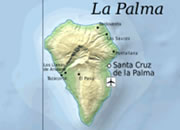 |
Where Are the Canary Islands? |
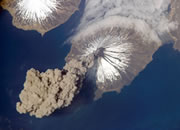 |
Mount Cleveland |
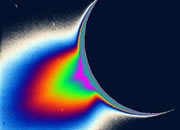 |
Solar System Volcanoes |
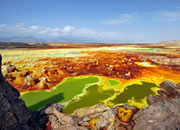 |
Dallol Volcano |
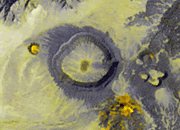 |
What is a Maar? |
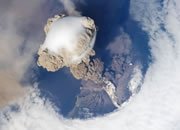 |
Spectacular Eruption Photos |
 |
Stromboli Volcano |
 |
Mount St. Helens |

Find Other Topics on Geology.com:

|

| ||

|

| ||

|

| ||

|

|
